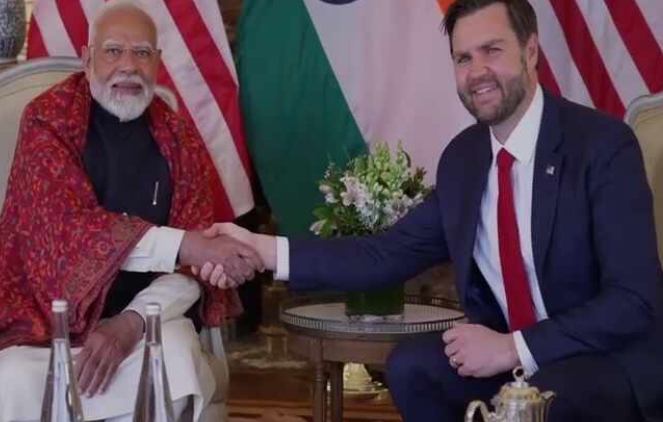India- US Energy Future
Syllabus
GS 2: India and its Neighbourhood
Why in the News?
Recently, India and the U.S. renewed strategic talks to enhance cooperation in clean energy, critical minerals, and nuclear power amid rising concerns over supply chain risks and China’s mineral dominance.

Introduction
- India and the United States are re-evaluating their strategic priorities, especially in energy and technology.
- With recent high-level discussions and growing geopolitical tensions, both nations are exploring deeper cooperation in critical minerals, nuclear energy, and technological innovation.
- These collaborations aim to ensure long-term sustainability, energy security, and resilient global supply chains.
Recent Developments
- Recently, U.S. Vice President J.D. Vance expressed a strong interest in deepening cooperation with India in energy and defence.
- India’s foreign policy team responded by emphasizing collaboration in four key areas:
- energy,defence,technology, and
- mobility of people.
- Although this dialogue is not new, it signals renewed political momentum to address longstanding strategic challenges through robust partnerships.
India’s Energy Security: Key Objectives
- India’s energy policy revolves around three core goals:
- Reliable Energy Access: Ensuring sufficient energy resources are available at predictable and stable prices.Resilient Supply Chains: Minimising risks of supply disruptions caused by geopolitical tensions or trade policies.
- Sustainability Goals: Transitioning to a greener energy mix to meet its climate commitments and future demand.
- These objectives are central to India’s cooperation with the U.S. and other allies in building robust and future-ready infrastructure.
Role of Critical Minerals in Energy Transition
- Critical minerals are vital for:
- Clean energy technologies like solar panels and wind turbines.Advanced defence systems.Semiconductors and electronic devices.
- Electric vehicles (EVs) and green hydrogen technology.
- However, current global supply chains are vulnerable.
China’s Strategic Hold on Critical Minerals
- China controls about 90% of the global rare earth processing market.
- Its decision in April 2024 to restrict exports again highlighted the risks of supply dependency.
- These restrictions, used periodically over the past decade, threaten energy transition plans worldwide.
India-U.S. Critical Minerals Agreement
- In 2024, India and the U.S. signed a Memorandum of Understanding (MoU) to diversify mineral supply chains.
- This agreement marks a pivotal step, but successful execution will depend on adopting the following principles.
Three Guiding Principles for Critical Minerals Cooperation
1. Broader Strategic Framing
- Critical minerals must be seen beyond a mining sector lens.
- They are essential for strategic sectors like clean energy, aerospace, and defence.
- Broad framing allows shared investments, skills development, and cross-sectoral collaboration.
2. Multilateral and Bilateral Coordination
- Cooperation should span bilateral (India-U.S.) and plurilateral (Quad, MSP) platforms.
- Create guarantees of supply and transparent cooperation frameworks.
- Focus must be on demand generation, not supply coercion.
Proposed Initiatives:
- India-U.S. Critical Minerals Consortium for joint exploration and processing.
- Joint investments in third countries (Africa, Latin America, Southeast Asia).
- Mineral Exchange Platform to facilitate real-time trade, backed by digital infrastructure.
- Blockchain Traceability Standards, similar to the EU’s “Battery Passport,” for transparent and traceable mineral use.
3. Long-Term Vision and Strategic Patience
- Mining and processing facilities require 12–16 years to become operational.
- Develop a 20-year cooperation plan with interim milestones.
- Align goals with India’s Critical Minerals Mission and the iCET (India-U.S. Initiative on Critical and Emerging Technology).
Strategic Stockpiles and Risk Mitigation
- Build joint strategic reserves for minerals like lithium, cobalt, and rare earths.
- Use existing infrastructure: India’s Strategic Petroleum Reserve and the U.S. National Defense Stockpile.
- This would protect against future trade wars or geopolitical blockades.
Multilateral Engagement via the Quad
- India, U.S., Australia, and Japan (Quad members) are strengthening supply chains through joint mineral projects.
- This includes sharing of mineral processing technologies, data transparency, and third-country collaborations.
India’s Global Role in Mineral Security
- India became the first non-G-7 country to join the Mineral Security Partnership (MSP).
- Hosting the upcoming Quad summit, India has a chance to formalise these initiatives and lead efforts toward global mineral sustainability.
Nuclear Energy: A Pillar of India’s Net-Zero Strategy
Growing Energy Demand
- As India’s electricity demand surges, the country needs reliable and low-carbon energy sources.
- Nuclear energy complements solar and wind by providing consistent baseline power.
India’s Nuclear Ambitions
- India targets 100 GW of nuclear capacity by 2047.
- Current capacity is just 8 GW, about 2% of total installed power capacity.
- Achieving the 2047 target requires adding 5–6 GW annually from the 2030s onward.
- Studies Highlight Greater Need
- Research by Council on Energy, Environment and Water (CEEW) suggests that India might need over 200 GW of nuclear capacity by 2070 for net-zero compliance.
Key Reforms Needed for Nuclear Expansion
1. Reducing Project Timelines
- Cutting construction time from 9 years to 6 years could reduce costs by 8%.
- This requires:
- Standardised reactor designsFaster regulatory approvals
- Efficient and skilled project teams
2. Involving the Private Sector
- Private firms can only invest if risks are mitigated.
- Need for:
- Credible power offtakersCompetitive bidding structures
- Long-term purchase agreements
- Small Modular Reactors (SMRs) are key:
- Lower capital costsIdeal for water-scarce regions
- Can power green steel production and AI infrastructure
Financing the Nuclear Transition
- Estimated capital requirement for 100 GW nuclear: $180 billion.
- India’s banking and NBFC sector has existing exposure of $200 billion to the power sector.
- Financial reforms needed to:Mobilise new capitalCreate investor confidence
- Attract foreign tech and partners
Enhancing Safety and Liability Reforms
Civil Liability for Nuclear Damage Act (2010)
- Current legal framework discourages private investment due to liability issues.
- Amendment required to attract both domestic and international investors.
- Technology Transfer and Modular Designs
- U.S. firm Holtec International approved to transfer SMR technology to Indian firms like:
- Larsen & Toubro
- Tata Consulting Engineers
- Indigenous modular reactor development could become a cornerstone of India’s energy future.
Safety and Waste Management
- Safety must remain paramount.
- India should adopt:
- Advanced waste handling
- Efficient decommissioning strategies
- Centralised waste infrastructure
- SMRs offer smaller emergency zones and air-cooled designs, but require robust waste protocols.
Building the Architecture of Long-Term Cooperation
- India and the U.S. should invest in the underlying systems supporting energy and technology partnerships:
- Data-sharing protocolsJoint workforce development programsInnovation corridors and research hubsTracking systems for investments
- Use platforms like iCET for strategic coordination and joint R&D.
Global Context: IMF Warning
- The IMF’s April 2025 World Economic Outlook highlights growing global uncertainty due to:
- Trade tensions
- Tariff barriers
- In this climate, India-U.S. strategic collaboration offers stability and confidence for long-term investments in energy and innovation.
Conclusion
India and the U.S. must build a long-term, resilient partnership in energy and technology. A joint vision backed by shared investment, innovation, and trust will ensure sustainable growth amid global geopolitical uncertainty.
Source: The Hindu
Mains Practice Question
Discuss the significance of the India-U.S. Critical Minerals agreement in the context of global supply chain security and energy transition.






